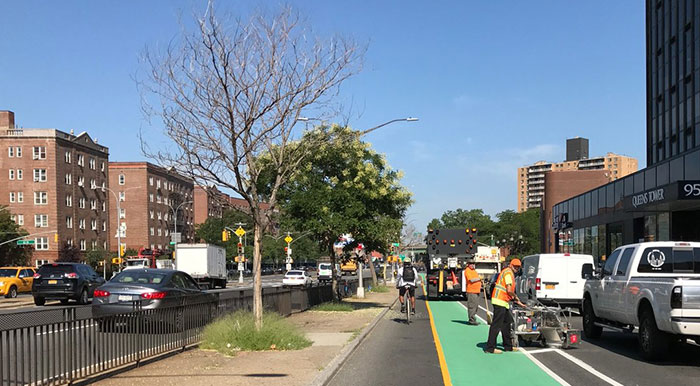Photo Courtesy of DOT
The conclusion of the analysis is that cycling has grown safer at the same time that its popularity has soared, according to Mayor de Blasio.
By Forum Staff
The dramatic increase in daily cycling has accompanied a corresponding increase in cycling safety, is one of the chief insights heralded in a comprehensive study of cyclist safety in the five boroughs released on Monday by Mayor Bill de Blasio.
Created by the Department of Transportation, the City Police Department, and the Department of Health and Mental Hygiene, “Safer Cycling: Bicycle Ridership and Safety in New York City” also looks at factors behind crashes, and provides a comprehensive action plan to further improve cycling safety in the years ahead, de Blasio added.
“While we continue to make progress on Vision Zero this year, one cyclist fatality is still too many,” de Blasio said. “The conclusion of this excellent multi-agency study – that cycling has grown safer at the same time that its popularity has soared – means that our Vision Zero efforts, including redesigning streets to add protected bike lanes, are making a real difference. With detailed and specific plans to make further improvements that protect cyclists in neighborhoods around the City, this study will help us keep that momentum going for years to come.”
Key study insights include:
• Improved safety trends – Cycling safety has improved significantly in recent years, according to the report; since 2006, bicycle ridership has more than doubled while cyclist fatalities, while still too high, have remained relatively flat (since 2000, between 12 and 24 fatalities per year). Cycling has increased faster than population or employment with an estimated 164 million bicycle trips in 2015 alone, up from nearly 66 million trips in 2006 – a 150-percent increase. Between 2011 and 2015, the city experienced an average of 12.8 cyclist fatalities per 100 million bicycle trips, compared to 44.2 cyclist fatalities per 100 million trips between 1996 and 2000, a decline of 71 percent.
• Citi Bike – The launch of Citi Bike coincided with a drop in cyclists killed or severely injured within the bike share area. The number of cyclists killed or severely injured declined by 17 percent within the bike-share zone after one year of operation, despite a recorded 8.2 million bike share trips in the first year of operation. More than 40 million Citi Bike trips have been taken over four years.
• Bicycle lanes – Between 2006 and 2016, the majority – 89 percent – of cyclist fatalities occurred on streets without a bicycle lane.
• Intersections – A majority of cyclist fatalities and severe injuries occur at intersections. Study results reveal the majority of cyclist fatalities (65 percent) and those killed/severely injured (89 percent) happen at intersections.
• Creating new “Priority Bicycle Districts” – A number of neighborhoods in the five boroughs have significant cyclist fatalities and severe injuries, but are underserved by the bicycle network. The study identifies 10 Priority Bicycle Districts, community boards with comparatively high numbers of cyclist fatalities and severe injuries and few bicycle lanes. These districts – seven in Brooklyn and three in Queens – represent 14 percent of the city’s bicycle network, but now have 23 percent of cyclist fatalities or severe injuries.
“With the tremendous growth of cycling in New York City, comes the responsibility of all users of our roadways to be cognizant of bicyclist safety,” said NYPD’s Chief of Transportation Thomas Chan. “Drivers need to be aware of the vulnerability of bicyclists and drive in a manner conducive to bicyclist safety. At the same time, bicyclists must also obey the rules of the road and have the proper equipment to ensure their visibility.”

